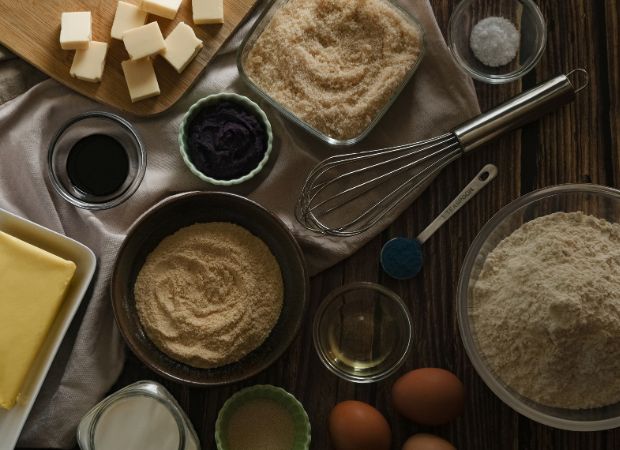Embarking on a gluten-free diet doesn’t mean saying goodbye to the joy of baking delicious treats. With the right know-how and a few simple adjustments, you can transform any recipe into a gluten-free masterpiece.
In this guide, we’ll explore the essential steps to adapt your favourite baking recipes for a gluten-free diet, ensuring every bite is as delightful as ever.
What is gluten?
Gluten – the protein found in wheat, barley and rye – is the backbone of traditional baking. It provides structure, elasticity and that satisfying chewiness to baked goods. When transitioning to gluten-free baking, it’s important to find substitutes that replicate these properties to achieve the desired texture and taste.
MUST-TRY RECIPE: Gluten-free carrot cake
The key to successful gluten-free baking lies in selecting the right flour or flour blend. There’s a wide variety of gluten-free flours available, each with its unique characteristics:
- Rice flour is a versatile gluten-free flour that works well in a variety of recipes, including cakes, cookies and bread.
- Almond flour, made from finely ground almonds, adds a rich, nutty flavour to baked goods and works particularly well in recipes that require a moist, dense texture.
- Coconut flour is high in fibre and adds a subtle coconut flavour to baked goods. It absorbs a lot of moisture, so it’s essential to use it in combination with other flours or adjust the liquid content in the recipe.
- Tapioca flour, also known as tapioca starch, adds lightness and crispness to baked goods. It’s often used in combination with other gluten-free flours to improve texture.
- Corn flour, also known as corn starch, adds a delicate sweetness and light texture to baked goods, making it ideal for cakes, cookies and muffins.
- Gluten-free oat flour, made from ground oats, adds a slightly sweet, nutty flavour to baked goods.
- Chickpea flour, made from ground chickpeas, offers a unique nutty flavour with a hint of sweetness to baked goods. It’s rich in protein and fibre, making it a nutritious choice for gluten-free baking.
- Buckwheat flour, ground from the seeds of the buckwheat plant, has a robust, earthy flavour and is packed with nutrients such as fibre, protein and minerals. It’s excellent for making hearty pancakes, muffins and bread, and adds a distinctive flavour and satisfying texture to baked goods.
Experimenting with flour blends
While each gluten-free flour has its advantages, creating a blend of flours often yields the best results. Experiment with different combinations to find the perfect balance of flavour and texture for your recipes. Most common gluten-free flour blends consist of a mixture of rice flour, potato starch, tapioca flour and xanthan gum or guar gum (to mimic the binding properties of gluten).
How to use binders
Since gluten provides the structure in traditional baking, it’s essential to use binders in gluten-free recipes to prevent crumbling. Xanthan gum and guar gum are commonly used to mimic the elasticity of gluten. Add them to your recipes in small amounts to ensure the right texture and consistency.
- For xanthan gum: Add approximately 1/4 to ½ teaspoon of xanthan gum per cup of gluten-free flour.
- For guar gum: Add around 1/4 to ½ teaspoon of guar gum per cup of gluten-free flour.
Another binder you can use is ground psyllium husk. Mix about ½ to 1 teaspoon of psyllium husk powder (per cup of gluten-free flour) with water according to the recipe instructions and allow it to sit for a few minutes until it forms a gel-like consistency. Then incorporate it into your batter or dough as you would any other binder. Psyllium husk powder is, however, highly absorbent, so use it sparingly and adjust based on the specific recipe and desired texture.
Common adjustments you might need to make
Gluten-free flours absorb moisture differently than wheat flour, which means you might need to make adjustments when it comes to the recipe.
Some gluten-free flours – such as almond or coconut flour – may absorb more moisture than others, while others – such as rice or tapioca flour – may absorb less. This variation means that when substituting gluten-free flour for wheat flour in recipes, adjustments may be necessary to achieve the desired texture and consistency.
Adding extra moisture or using a combination of gluten-free flours can help compensate for any differences in absorption rates. You may also need to add extra eggs or more fats to maintain moisture and prevent dryness.
Additionally, consider boosting the leavening agents, such as baking powder or baking soda, by ½ teaspoon to ensure proper rising in your baked goods.
Tip: Trust your gut! If the batter feels too runny or too thick, it probably is, so adjust accordingly. Generally speaking, runny batters do require longer baking times, but they can contribute to a softer and more delicate crumb.
MUST-TRY RECIPE: Small-batch gluten-free banana bread
Substituting ingredients using cup measurements instead of grams can be more effective, especially in gluten-free baking, due to the variability in the weights of different flours.
While using grams for precise measurements is common in professional baking, it may not always translate seamlessly when substituting flours, as gluten-free flours can vary significantly in density and moisture content.
Cup measurements also offer a simpler and more user-friendly approach, allowing for easier adjustments and intuitive substitutions.
Tip: Do not attempt to substitute coconut flour for wheat flour one for one, as this can lead to disastrous results.
Testing, testing, and more testing
Like any culinary adventure, gluten-free baking requires experimentation and fine-tuning. You’re probably going to have a flop or two, but you’ll be a better baker for it! Keep detailed notes of your adaptations, including changes in ingredients, measurements and baking times.

